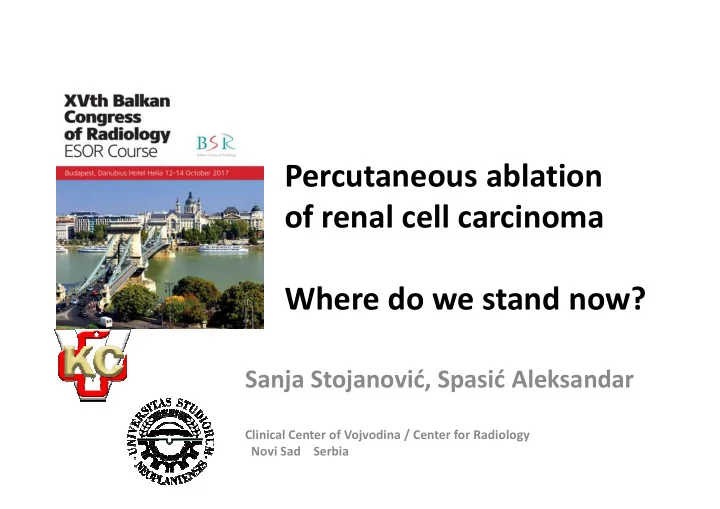

Percutaneous ablation of renal cell carcinoma Where do we stand now? Sanja Stojanović, Spasić Aleksandar Clinical Center of Vojvodina / Center for Radiology Novi Sad Serbia
Renal cell carcinoma • approximately less than 4 % of all new cancers in the western world • The detection rate has been increasing in recent years • Incidental finding
Which RCCs are we speaking about • T1 – T1a: tumour confined to kidney, <4 cm – T1b: tumour confined to kidney, >4 cm but <7 cm • T2: • T3: • T4:
4 cm Treated area deployment of thermal energy
ELECTRODES
How to enlarge area of ablation
Hyperthermic ablation in depth understanding of the mechanism Thermal conduction from small heating zone Mechanism of celullar injury Central zone – necrosis Periphery - sublethal Immune activation – antigen presentation Chu CF, Dupuy D. Thermal ablation of tumours: biological mechanisms and advances in therapy. Cancer; 2014.
Cryoablation Liquefied gases (Argon) -20 to -40°C 1cm beyond the lesion Mechanism of cellular injury Even better immune activation - sometime inactivation Chu CF, Dupuy D. Thermal ablation of tumours: biological mechanisms and advances in therapy. Cancer; 2014.
Immunomodulation Often too weak to completely overcome disease Synergy with ablation - imunnoadjuvants Chu CF, Dupuy D. Thermal ablation of tumours: biological mechanisms and advances in therapy. Cancer; 2014.
Partial Thermal Nephrectomy Ablation
PATIENT SELECTION BIAS
- Patients that are not fit or are not willing to undergo surgical treatment - Active surveilance only for those patients with cT1a RCC that cannot undergo percutaneous treatment
Partial Thermal Nephrectomy Ablation Armamentorium • Lethal mechanism • Immunomodulation • Pathology • Image guidance • Effect of procedure •
RF CRYO Cornelis FH et al. A Comparative Study of Ablation Boundary Sharpness After Percutaneous Radiofrequency, Cryo-, Microwave, and Irreversible Electroporation Ablation in Normal Swine Liver and Kidneys. CIRSE; 2017.
=iopsy - mandatory Percentage Survival Fuhrman grading 18G needle Disease Specific Survival (months) Metastases Multiple subtypes of RCC T1a – 7% =yopsy CC Pathology CC �blaDon RCC 3-4cm – 11% Further therapy by oncologists Comparisson with other modalities (PN)
Patient selection • Small renal mass: T1a; T1b ? • Comorbid conditions • Advanced age • Single kidney • Multiple masses (VHL)
Ideal lesion for RF Small (≤ 3cm/4cm?) • Posterior • Exophytic • Far away from critical • structures
Multiple tumours Proximity of colon Proximity of spleen Proximity of hilus - pyeloureter - vascular
Image guidance CT US – inferior control ablation induced artifacts MRI – robust equipement availibility
colon Hydrodissection to push away structures in close proximity RCC infusion of liquid One needle Two needles
Complications Hemorrhage (thinner or thicker needles) – Subcapsular – Retroperitoneal Hematuria – Central locations – Cryoablation better tolerated by pyelocaliceal wall – Pyeloperfusion (cold or warmed liquids)
Atwell TD et al. Percutaneous Ablation of Renal Masses Measuring 3.0 cm and Smaller: Comparative Local Control and Complications After Radiofrequency Ablation and Cryoablation. AJR; 2013.
Prediction of complications % Major Complication R adius E xophytic/endophytic N earness to collecting system A nterior/posterior 4 - 6 7 - 9 10 - 12 R.E.N.A.L. Score L ocation relative to polar lines Schmit GD et al. Usefulness of R.E.N.A.L. Nephrometry Scoring System for Predicting Outcomes and Complications of Percutaneous Ablation of 751 Renal Tumors. J.Urology; 2013.
10 - 12 % Local Failure 7 - 9 4 - 6 R adius Months Post Treatment E xophytic/endophytic N earness to collecting system A nterior/posterior Prediction L ocation relative to polar lines of local success
Approach Electrode position Skin landmark 90° angle
RF or PN
Single kidney / multiple RCC - Renal reserve - Partial nephrectomy or thermal ablation ? - Control of complications
T1a lesion 26mm lesion Position 1 Position 2 After ablation
Control sectional imaging - 4 weeks after ablation – rest of the ablated tumour - after 3, 6, 9 or 12 months – institution protocol - G�' Kli8uidL complicaDons 92#dronephrosis, CollecDonsHHH: CC C% 4!7 3 months 1 #ear 2 #ears
Follow up • Early follow up – imaging not recommended unless complication (bleeding..) suspected • Late follow up - no consensus on chosen modality – Comparation to preoperative imaging – Lack of enhancement – Decrease in size of the ablative zone – Peripheral enhancement (usualy disappears after 6 months) – Recurrent tumor versus inflammatory changes -- New baseline after 6 months
Conclusion - Guidelines - T1a(b) tumours - Biopsy - Pursuing excellence in technique and understanding of lethal mechanisms - Learning curve
Thank you for your attention!
Recommend
More recommend